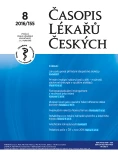Rehabilitation after total knee and hip arthroplasty
Authors:
Eduard Šťastný; Tomáš Trč; Theodoros Philippou
Authors‘ workplace:
Klinika dětské a dospělé ortopedie a traumatologie 2. LF UK a FN Motol
Published in:
Čas. Lék. čes. 2016; 155: 427-432
Category:
Review Articles
Overview
The main purpose of total hip replacement is to relieve hip pain and recover the lost mobility of the joint. The postoperative functionality of the hip endoprosthesis is closely related to proper physiotherapy. A good range of motion, sufficient pain reduction and minimum disruption to the muscle tissues are conditions allowing the patients to perform individualized muscle strengthening exercises and to exercise the newly gained mobility, following practice sessions during the early postoperative period still in hospital. The authors describe the individual fazes of the physiotherapy and summarize the principles, which lead to a successful rehabilitation of the patient and his early recovery as well as return to normal life activities.
Keywords:
total hip replacement, total knee replacement, rehabilitation, physiotherapy
Sources
1. Véle F. Kinezilogie posturálního systému. Karolinum, Praha, 1995.
2. Buechel FF sr., Buechel FF jr., Pappas MJ, D’Alesio J. Twenty years evaluation of meniscal bearing and rotating platform knee replacement. Clin Orthop 2001; 388: 41–50.
3. Rooks DS, Huang J, Bierbaum BE. Effect of preoperative exercise on measures of functional status in men and women undergoing total hip and knee arthroplasty. Arthritis Rheum 2006; 55: 700–708.
4. Janda V. Introduction to the functional pathology of the motorical system. Physioterapy in Sports 1982; 3: 39–42.
5. Munzinger U, Boldt J, Keblish P. Primary knee arthroplasty. Springer Verlag, Berlin, Heidelberg, New York, 2004.
6. Trč T, Šťastný E. Rehabilitace po implantaci totální náhrady kolenního kloubu. Ortopedie 2013; 7: 52–56.
7. Šťastný E, Trč T, Philipou T. Rehabilitace po implantaci totální náhrady kyčelního kloubu. Ortopedie 2013; 7: 58–61.
8. Berman AT, Bosaco S, Israelite C. Evaluation of total knee arthroplasty using isokinetic testing. Clin Orthop 1991; 171: 106–113.
9. Canale TS. Campbell’s Operative Orthopaedics (9th ed.). Mosby, St. Louis, 1998.
10. Beaupre LA et al. Exercise combined with passive motion or slider board therapy compared with exercise only. A randomized controlled trial of patients following knee arthroplasty. Phys Ther 2001; 1: 1029–1037.
11. Uiberlayová I. Rehabilitace pacientů po totálních endoprotézách kyčelního a kolenního kloubu, lázeňská léčba. Ortopedie 2010; 4: 79–88.
12. Sapega AA. Muscle performance evaluation in orthopaedic practice. J Bone Jt Surg 1990; 72-A: 562–1574.
13. Mahomed NN et al. The importance of patient expectations in predicting functional outcomes after total joint arthroplasty. J Rheumatol 2002; 29: 1273–1279.
Labels
Addictology Allergology and clinical immunology Angiology Audiology Clinical biochemistry Dermatology & STDs Paediatric gastroenterology Paediatric surgery Paediatric cardiology Paediatric neurology Paediatric ENT Paediatric psychiatry Paediatric rheumatology Diabetology Pharmacy Vascular surgery Pain management Dental HygienistArticle was published in
Journal of Czech Physicians

- Metamizole vs. Tramadol in Postoperative Analgesia
- Metamizole at a Glance and in Practice – Effective Non-Opioid Analgesic for All Ages
- Advances in the Treatment of Myasthenia Gravis on the Horizon
- What Effect Can Be Expected from Limosilactobacillus reuteri in Mucositis and Peri-Implantitis?
- The Importance of Hydration in Wound Healing
Most read in this issue
- Avascular necrosis of the femoral head
- Femoroacetabular impingement − treatment options
- Rehabilitation after total knee and hip arthroplasty
- Limb shortening in the management of leg length discrepancy
